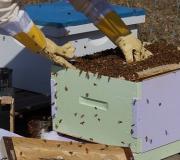Functions of culture. Adaptive function of consciousness
The complex and multi-level structure of culture determines the diversity of its functions in the life of society and individuals. But there is no complete unanimity among culturologists on the question of the number of cultural functions. Nevertheless, they all agree with the idea of multifunctionality of culture, with the fact that each of its components can perform different functions. Comparison of different points of view on this issue allows us to conclude that the main functions of culture include adaptive, symbolic (significative), cognitive, informational, communicative, integrative, regulatory, axiological and etc.
Adaptive function of culture
The most important function of culture is adaptive, allowing a person to adapt to the environment, which is a necessary condition survival of all living organisms in the process of evolution. But a person does not adapt to changes environment, as other living organisms do, but changes their environment in accordance with their needs, adapting it to themselves. At the same time, a new, artificial world is created - culture. In other words, a person cannot lead a natural lifestyle like animals, and in order to survive, he creates an artificial habitat around himself.
Of course, a person cannot achieve complete independence from the environment, since each specific form of culture is largely determined natural conditions. The type of economy, housing, traditions and customs, beliefs, rites and rituals of peoples will depend on natural and climatic conditions.
As culture develops, humanity provides itself with increasing security and comfort. But, having gotten rid of previous fears and dangers, a person comes face to face with new threats that he creates for himself. So, today there is no need to be afraid of such formidable diseases of the past as the plague or smallpox, but new diseases have appeared, such as AIDS, for which no cure has yet been found, and in military laboratories other deadly diseases created by man himself are waiting in the wings. Thus, a person needs to protect himself not only from the natural environment, but also from the world of culture.
The adaptive function has a dual nature. On the one hand, it manifests itself in the creation necessary for a person means of protection from the outside world. These are all the products of culture that help the primitive, and later civilized man survive and feel confident in the world: using fire, creating productive Agriculture, medicine, etc. These are the so-called specific means of protection person. These include not only objects material culture, but also those specific means that a person develops to adapt to life in society, keeping him from mutual destruction and death. This government agencies, laws, customs, traditions, moral standards, etc.
There are also nonspecific means of protection human being is culture as a whole, existing as a picture of the world. Understanding culture as a “second nature”, a world created by man, we emphasize the most important property human activity and culture - the ability to “double” the world, highlighting sensory-objective and ideal-imaginative layers in it. Culture as a picture of the world makes it possible to see the world not as a continuous flow of information, but to receive this information in an ordered and structured form.
Each person, like each generation, comes into the world at a certain level of cultural development. To live in this world, a person needs all the cultural gains achieved by society. They adapt a person to the world, adapt him to reality, helping him to carry out his life activities. Culture offers everyone a system of actions that connects with the surrounding reality, ways and means of solving the problems that confront them. Society as a whole, in the face of any cataclysms (ecological crisis, destructive war, epidemic, etc.) draws from culture the strength, methods and forms of its revival and further development. For example, at the beginning of the Middle Ages - in V-VI centuries, which are called “dark”, - the destructive power of barbarian tribes destroyed almost all achievements ancient world, cities lay in ruins, many crafts were lost, and what the barbarians did not have time to do was completed by epidemics. Europe returned to the wooden plow and other primitive tools, and wooden construction resumed again. But the cultural memory of humanity has made it possible to restore, develop and improve life European peoples. Already during the reign Charlemagne(742-814), who did not disdain to learn to read and write at the age of 40 and gathered many Eastern scientists and artists at his court, managed to revive many of the achievements of European culture.
2. Cognitive function
Every thing created by people represents objectified knowledge. In order to correctly use a thing, you must first disseminate this knowledge and make it your own (master). Thus, any human activity becomes a source of knowledge. In addition, in society there are forms of preserving knowledge; morality preserves knowledge about human relations; art and religion attempt - each in its own form - to provide systematic knowledge about the world; and, finally, science examines the essential aspects and connections of the world. Culture allows one to successfully master these forms of knowledge in any field of activity.
3. Communication function
Usually the term communication(lat. communicatio<communico“I make it common, I connect, I communicate”) is understood as communication. The fact is that communication “involves direct contact of one person with another,” “an element of personal relationships, a live exchange of something (for example, information, activities).” This form of relations in society is a special case of communication. But there are other levels of such relationships - communication between generations, peoples, eras in time and space. It is culture that makes such communication possible and productive. Culture retains forms and methods of communication and transmission of information, offers certain traditions, accumulated experience, standards, ideals, and more. We can say that culture is communicative in contrast to lack of culture, for which interaction with the world is expressed in a destructive or hostile form, in one conflict or another, and is therefore impossible or difficult.
Instrumental function.
Topic 9
Functional design as a method.
Typification as a functional “portrait” of space. The instrumental function as an image of human action aimed at a closed environment in its material and spatio-temporal characteristics.
Involvement of scenario and compositional modeling methods.
The instrumental image of a person as one of the system-forming factors of formation.
Objects as a connecting functional link in the “person – thing – environment” system. Adaptive function as a quality of the environment from a human point of view. A comfortable environment is adapted, “fitted to the person.”
When designing an interior, the designer models various situations of its functioning in the human environment. These functions are diverse, and in order to draw a functional “portrait” of space, it is extremely important to typify this space. Such typification should be based on a holistic and generalized idea of human activity as a system.
So, when designing an instrumental function, the designer must recreate in it the image of human action aimed at the external environment in its material and spatio-temporal characteristics. Here you can use methods of scenario and compositional modeling. Modeling various situations of instrumental action with space (movement, work, rest, etc.), the designer step by step constructs, sculpts, shapes its shape, capturing in it the image of the human body (it is no coincidence that the concept of anthropomorphism of the object environment occupies a very important place in design ).
The instrumental image of a person is one of the system-forming factors of formation. Objects in the environment are considered in this case as a connecting functional link in the “person – thing – environment” system. The instrumental function covers all the properties of a thing resulting from the way of human action with it. In the process of designing a subject environment, it is almost always extremely important to highlight this function, abstracting from all others. It should be borne in mind that the figurative expression of the instrumental function is normalized by culture. Our movements, postures, gestures - the entire technique of our bodily actions has a cultural background, in connection with this, when designing an instrumental function, it is necessary to recreate the cultural image of the instrumental function itself.
The instrumental function is the flip side of the adaptive function and vice versa, because by influencing external nature and changing it, a person changes his own nature. The objective world is the “inorganic body” of a person, and this means that in it a person has acquired his own adaptive functions. The adaptive function is that it maintains the external environment in a state favorable for the flow of life processes. Our clothing, housing, workplace equipment, the artificial environment of spaceships - all this is an adapted objective world that creates normal living conditions where a person cannot exist or where his habitat is uncomfortable.
If the instrumental function indicates the direction of human influence on the external environment, then adaptive function– about the quality of this environment from a human point of view. One of these qualities is, for example, comfort. A comfortable environment - adapted, “fitted” to a person - ceases to be noticed and experienced as something external, since a person does not have to constantly overcome the distance between himself and the world. We feel the air temperature in the room only when it is very different from the optimal one; an uncomfortable chair makes us unkindly remember the person who designed it; a thing that has not found an exact place in the interior annoys us with its constant presence. The main task in functional design is, on the one hand, to determine the forms and methods of human activity that are consistent with nature, and on the other hand, to create a harmonious subject environment for humans.
When designing an adaptive, as well as an instrumental function of a thing, a cultural image of human action is projected onto the external environment. After all, it is obvious that some things create an adaptive environment for a resident of a rural area, others - for a city dweller; a Japanese feels good on the tatami, and a European feels good in a chair, etc.
The design concept of the adaptive function itself should be built within an artistic image that recreates the holistic objective world of a person and determines the functional place of each thing in it. Adaptation processes are considered within the framework of such ideas, where a person acts as the leading element of the system, introducing into it social, psychological, physiological, anthropometric and other parameters.
Social functions of culture
The social functions that culture performs allow people to carry out collective activities, optimally satisfying their needs. The main functions of culture include:
social integration - ensuring the unity of humanity, a common worldview (with the help of myth, religion, philosophy);
organization and regulation of the joint life activities of people through law, politics, morality, customs, ideology, etc.;
providing people with the means to live (such as cognition, communication, accumulation and transfer of knowledge, upbringing, education, stimulation of innovation, selection of values, etc.);
regulation of certain spheres of human activity (culture of life, culture of recreation, culture of work, culture of nutrition, etc.).
Thus, the cultural system is not only complex and diverse, but also very mobile. Culture is an integral part of the life of both society as a whole and its closely interconnected subjects: individuals, social communities, social institutions.
The complex and multi-level structure of culture determines the diversity of its functions in the life of a person and society. But there is no complete unanimity among culturologists regarding the number of functions of culture. Nevertheless, all authors agree with the idea of multifunctionality of culture, with the fact that each of its components can perform different functions.
The adaptive function is the most important function of culture, ensuring human adaptation to the environment. It is known that the adaptation of living organisms to their habitat is a necessary condition for their survival in the process of evolution. Their adaptation occurs due to the work of the mechanisms of natural selection, heredity and variability, which ensure the survival of individuals best adapted to the environment, the preservation and transmission of useful characteristics to subsequent generations. But what happens is completely different: a person does not adapt to his environment, to changes in the environment, like other living organisms, but changes his environment in accordance with his needs, remaking it for himself.
When the environment is transformed, a new, artificial world is created - culture. In other words, a person cannot lead a natural lifestyle like animals, and in order to survive, he creates an artificial habitat around himself, protecting himself from unfavorable environmental conditions. Man gradually becomes independent of natural conditions: if other living organisms can live only in a certain ecological niche, then man is able to master any natural conditions at the cost of forming an artificial world of culture.
Of course, a person cannot achieve complete independence from the environment, since the form of culture is largely determined by natural conditions. The type of economy, housing, traditions and customs, beliefs, rites and rituals of peoples depend on natural and climatic conditions. So. the culture of mountain peoples differs from the culture of peoples leading a nomadic lifestyle or engaged in maritime fishing, etc. Southern peoples use a lot of spices when preparing food to delay spoilage in hot climates.
As culture develops, humanity provides itself with increasing security and comfort. The quality of life is constantly improving. But having gotten rid of old fears and dangers, a person comes face to face with new problems that he creates for himself. For example, today there is no need to be afraid of the terrible diseases of the past - the plague or smallpox, but new diseases have appeared, such as AIDS, for which no cure has yet been found, and in military laboratories other deadly diseases created by man himself are waiting in the wings. Therefore, a person needs to protect himself not only from the natural environment, but also from the world of culture, artificially created by man himself.
The adaptive function has a dual nature. On the one hand, it manifests itself in the creation of specific means of human protection - the necessary means of protection for a person from the outside world. These are all cultural products that help a person survive and feel confident in the world: the use of fire, storing food and other necessary things, creating productive agriculture, medicine, etc. Moreover, these include not only objects of material culture, but also those specific means that a person develops to adapt to life in society, keeping him from mutual destruction and death - state structures, laws, customs, traditions, moral norms, etc. d.
On the other hand, there are non-specific means of human protection - culture as a whole, existing as a picture of the world. Understanding culture as a “second nature”, a world created by man, we emphasize the most important property of human activity and culture - the ability to “double the world”, highlighting sensory-objective and ideal-imaginative layers in it. By connecting culture with the ideal-shaped world, we obtain the most important property of culture - to be a picture of the world, a certain network of images and meanings through which the world around us is perceived. Culture as a picture of the world makes it possible to see the world not as a continuous flow of information, but as ordered and structured information. Any object or phenomenon of the external world is perceived through this symbolic grid, it has a place in this system of meanings, and it is often assessed as useful, harmful or indifferent to a person.




